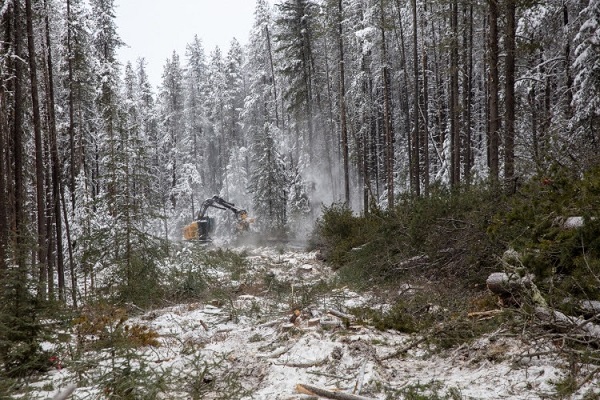Alberta
Community Fireguard Program Protecting Canmore and the Bow Valley from wildfires

Construction of the Bow Valley Community Fireguard near Canmore.
Mitigating the risks of catastrophic wildfires is a primary focus for Alberta’s government. With increased wildfire activity in recent years, it is crucial that communities at risk are prepared. The Community Fireguard Program is critical to these efforts. By removing trees surrounding vulnerable communities that can act as fuel in the event of fires, the program helps ensure that residents, homes, businesses and critical infrastructure are better protected from the devastating effects of wildfires.
Construction on the new Bow Valley Community Fireguard started in late fall 2024, after the project received $750,000 in provincial funding administered by the Forest Resource Improvement Association of Alberta. Project partners include the Town of Canmore, Municipal District of Bighorn and the Kananaskis Improvement District, with support from Alberta’s government.
“Alberta faced significant wildfire seasons over the last two years. The reality is that decades of fire suppression left our forests aging and vulnerable. By working together with our at-risk communities, we are taking steps to increase wildfire resilience across Alberta.”
Ongoing work on the fireguard, which includes a combination of mechanical tree removal and forest thinning, will significantly reduce the potential for a wildfire for years to come. Additional work is required to complete the entire fireguard over the next three to five years and planning is underway for the next funding approval and stage of construction.
“Wildfire is the hazard that poses the greatest risk to Canmore. With hotter, longer and more intense fire seasons, work on building the Bow Valley Community Fireguard is critical to ensuring that we have the means and the plans to combat this significant threat to people, property and critical infrastructure.”
“The Bow Valley Community Fireguard is a massive undertaking made possible through the province’s commitment to strengthening the wildfire resiliency of our communities. We are thankful for their continued support and leadership in advancing wildfire prevention initiatives across Alberta. We are also grateful for the countless hours of effort behind the scenes from the teams of the MD of Bighorn, the Town of Canmore, and the Kananaskis Improvement District that have brought this project to life to ensure the Bow Valley has a safer future for generations to come.”
Alberta’s government is taking significant steps to enhance wildfire preparedness across the province in preparation for the 2025 wildfire season, with several other fireguard initiatives currently underway. In Whitecourt, fireguard construction is ongoing, while in Hinton, fireguard planning is in progress. Swan Hills is focused on debris clean-up from 2023 fireguard construction to ensure continued wildfire protection for the area.
Additionally, work is underway to hire more wildland firefighters, who will receive specialized training at the Hinton Training Centre, which also provides free online training to municipalities and local fire departments. To support local communities, the province maintains mutual aid and resource-sharing agreements to ensure access to specialized firefighting equipment when needed.
The FireSmart program continues to help make properties more resistant to wildfires, and its principles are being implemented across the province. Alberta’s government is also continuing to implement prescribed burns and selective harvesting to reduce the risks of wildfires by removing aging trees.
Aggressive measures to reduce the mountain pine beetle population have also been effective, with work ongoing to cut and burn infested trees as needed.
Quick facts
- The Community Fireguard Program was launched in 2023 to enhance wildfire preparedness for communities at risk of wildfires.
- Alberta’s government invested $5 million to support emergency fireguard construction in 2023, in response to extreme wildfire activities.
- Emergency fireguards were constructed in Buck Creek, Grande Prairie, Dimsdale, Lac Ste. Anne, Valleyview, Gift Lake and Fox Creek.
- The program received an additional $14 million in 2024.
Related information
Alberta
Red Deer Justice Centre Grand Opening: Building access to justice for Albertans

The new Red Deer Justice Centre will help Albertans resolve their legal matters faster.
Albertans deserve to have access to a fair, accessible and transparent justice system. Modernizing Alberta’s courthouse infrastructure will help make sure Alberta’s justice system runs efficiently and meets the needs of the province’s growing population.
Alberta’s government has invested $191 million to build the new Red Deer Justice Centre, increasing the number of courtrooms from eight to 12, allowing more cases to be heard at one time.
“Modern, accessible courthouses and streamlined services not only strengthen our justice
system – they build safer, stronger communities across the province. Investing in the new Red Deer Justice Centre is vital to helping our justice system operate more efficiently, and will give people in Red Deer and across central Alberta better access to justice.”

Government of Alberta and Judiciary representatives with special guests at the Red Deer Justice Centre plaque unveiling event April 22, 2025.
On March 3, all court services in Red Deer began operating out of the new justice centre. The new justice centre has 12 courtrooms fully built and equipped with video-conference equipment to allow witnesses to attend remotely if they cannot travel, and vulnerable witnesses to testify from outside the courtroom.
The new justice centre also has spaces for people taking alternative approaches to the traditional courtroom trial process, with the three new suites for judicial dispute resolution services, a specific suite for other dispute resolution services, such as family mediation and civil mediation, and a new Indigenous courtroom with dedicated venting for smudging purposes.
“We are very excited about this new courthouse for central Alberta. Investing in the places where people seek justice shows respect for the rights of all Albertans. The Red Deer Justice Centre fills a significant infrastructure need for this rapidly growing part of the province. It is also an important symbol of the rule of law, meaning that none of us are above the law, and there is an independent judiciary to decide disputes. This is essential for a healthy functioning democracy.”
“Public safety and access to justice go hand in hand. With this investment in the new Red Deer Justice Centre, Alberta’s government is ensuring that communities are safer, legal matters are resolved more efficiently and all Albertans get the support they need.”
“This state-of-the-art facility will serve the people of Red Deer and surrounding communities for generations. Our team at Infrastructure is incredibly proud of the work done to plan, design and build this project. I want to thank everyone, at all levels, who helped make this project a reality.”
Budget 2025 is meeting the challenge faced by Alberta with continued investments in education and health, lower taxes for families and a focus on the economy.

Quick facts
- The new Red Deer Justice Centre is 312,000 sq ft (29,000 m2). (The old courthouse is 98,780 sq ft (9,177 m2)).
- The approved project funding for the Red Deer Justice Centre is about $191 million.
Alberta
Made in Alberta! Province makes it easier to support local products with Buy Local program

Show your Alberta side. Buy Local. |
When the going gets tough, Albertans stick together. That’s why Alberta’s government is launching a new campaign to benefit hard-working Albertans.
Global uncertainty is threatening the livelihoods of hard-working Alberta farmers, ranchers, processors and their families. The ‘Buy Local’ campaign, recently launched by Alberta’s government, encourages consumers to eat, drink and buy local to show our unified support for the province’s agriculture and food industry.
The government’s ‘Buy Local’ campaign encourages consumers to buy products from Alberta’s hard-working farmers, ranchers and food processors that produce safe, nutritious food for Albertans, Canadians and the world.
“It’s time to let these hard-working Albertans know we have their back. Now, more than ever, we need to shop local and buy made-in-Alberta products. The next time you are grocery shopping or go out for dinner or a drink with your friends or family, support local to demonstrate your Alberta pride. We are pleased tariffs don’t impact the ag industry right now and will keep advocating for our ag industry.”
Alberta’s government supports consumer choice. We are providing tools to help folks easily identify Alberta- and Canadian-made foods and products. Choosing local products keeps Albertans’ hard-earned dollars in our province. Whether it is farm-fresh vegetables, potatoes, honey, craft beer, frozen food or our world-renowned beef, Alberta has an abundance of fresh foods produced right on our doorstep.
Quick facts
- This summer, Albertans can support local at more than 150 farmers’ markets across the province and meet the folks who make, bake and grow our food.
- In March 2023, the Alberta government launched the ‘Made in Alberta’ voluntary food and beverage labelling program to support local agriculture and food sectors.
- Through direct connections with processors, the program has created the momentum to continue expanding consumer awareness about the ‘Made in Alberta’ label to help shoppers quickly identify foods and beverages produced in our province.
- Made in Alberta product catalogue website
Related information
-

 Business2 days ago
Business2 days agoChinese firm unveils palm-based biometric ID payments, sparking fresh privacy concerns
-

 Business1 day ago
Business1 day agoIs Government Inflation Reporting Accurate?
-

 2025 Federal Election2 days ago
2025 Federal Election2 days agoConservatives promise to ban firing of Canadian federal workers based on COVID jab status
-

 2025 Federal Election1 day ago
2025 Federal Election1 day agoCarney’s Hidden Climate Finance Agenda
-

 Environment2 days ago
Environment2 days agoExperiments to dim sunlight will soon be approved by UK government: report
-

 International2 days ago
International2 days agoPope Francis Got Canadian History Wrong
-

 2025 Federal Election1 day ago
2025 Federal Election1 day agoWhen it comes to pipelines, Carney’s words flow both ways
-

 2025 Federal Election1 day ago
2025 Federal Election1 day agoStudy links B.C.’s drug policies to more overdoses, but researchers urge caution





